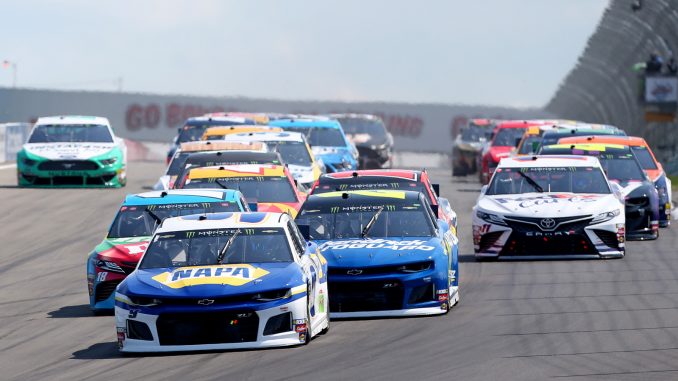
After hearing complaints about the lack of action on its short tracks and road courses, NASCAR officials announced rules changes Tuesday for the 2020 Cup Series that feature a reduced-downforce package.
The new package has significantly smaller spoilers, splitters and other aerodynamic devices in an effort to place a greater emphasis on handling and driver input with less stabilizing downforce on those tracks.
“Our first and foremost core goal is to deliver great racing, and I think that we constantly evaluate the things that we do on the race track, however and wherever we need to, to improve that situation for them,” said John Probst, NASCAR Senior Vice President, Innovation and Racing Development. “And as part of our normal ongoing critique of ourselves and how we’re doing, we just felt like this was a good opportunity for us to improve the on-track product at the short tracks and road courses.”
The changes will be in effect for nine of the 24 layouts — three road courses and six ovals — that the NASCAR Cup Series will visit in 2020.
The six oval tracks that will use the new rules this season:
-Bristol Motor Speedway (.533 miles)
-Dover International Speedway (1 mile)
-Martinsville Speedway (.526 miles)
-New Hampshire Motor Speedway (1.058 miles)
-Phoenix Raceway (1 mile)
-Richmond Raceway (.75 miles)
All three road courses on the Cup Series schedule will have the new rules in place:
-Charlotte Motor Speedway Roval (2.28 miles)
-Sonoma Raceway (2.52 miles)
-Watkins Glen International (2.45 miles)
Among the changes for those specific tracks:
-A significantly smaller rear spoiler, which shrinks from an 8-inch height to 2.75 inches.
-The front splitter’s overhang will now measure a quarter inch (down from 2 inches), with approximately 2-inch wings (reduced from 10.5 inches).
-Alterations to the radiator pan, removing its vertical fencing in an effort to reduce front-end downforce. The dimensions of the pan remain the same.
The package is similar rules used in the 2017-18 seasons.
In 2018 both races on the Bristol Motor Speedway high-banked half-mile were decided by less than a second; Joey Logano edged Denny Hamlin to the line by a scant .107-second for his fall Martinsville Speedway short track win in 2018 and both the 0.75-mile Richmond Raceway trophies were determined by less than a second: Kyle Busch’s .511-second victory over Chase Elliott in the spring and his .777-second win over Joe Gibbs Racing teammate Denny Hamlin in the fall.
“So instead of just coming out and creating a completely new aero spec that’s unknown to possibly us and more importantly the industry, we felt like we’d go back to something that’s tried and true for us and go back to a package that we had run recently,” Probst said. “At the same time, we did make some small adjustments to that package so that it would fit with our current intermediate speedway package so that we’d minimize further the necessity of the teams to have to develop this package.”
Probst said that the aerodynamic changes were met with a “broad base of support” in meetings that were initially held with stakeholders — spanning drivers, team engineers and managers, Goodyear representatives, manufacturers and broadcast partners — during NASCAR Champions Week in December at Nashville, Tennessee.
“Certainly from our standpoint, we feel like this is a step in the right direction to create more side-by-side, exciting moments during the race,” Probst said. “Obviously the proof will be in the pudding, but this is certainly something that we have run before that’s had good results.”
“Our goal has always been to provide the best possible racing for our fans, regardless of venue,’’ NASCAR Executive Vice President and Chief Racing Development Officer Steve O’Donnell said.
“We ended up in a really good place I think for short tracks and road courses in 2020,’’ O’Donnell said, adding, “I really applaud the teams for working together with us to going back to a package that we know works. The drivers had asked for that low downforce package as well at the short tracks. We’re going to see that.
“The fans have wanted that and asked for it and we’re going to deliver on those tracks that are outlined and think it will certainly make an impact on the racing and hopefully be a big improvement for 2020.’’
- Spire Motorsports confirms split with Corey LaJoie - July 25, 2024
- Kyle Larson wins NASCAR Brickyard 400 after overtime chaos - July 21, 2024
- Photos: NASCAR at the Brickyard Sunday July 21, 2024 - July 21, 2024